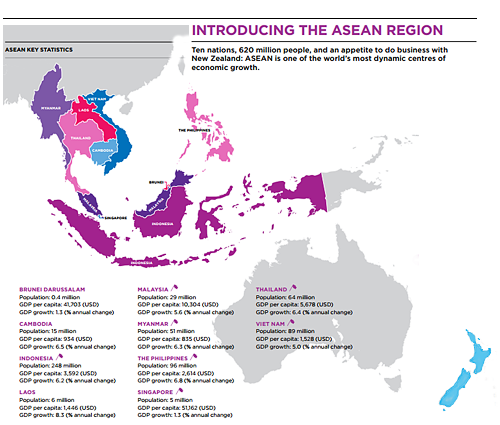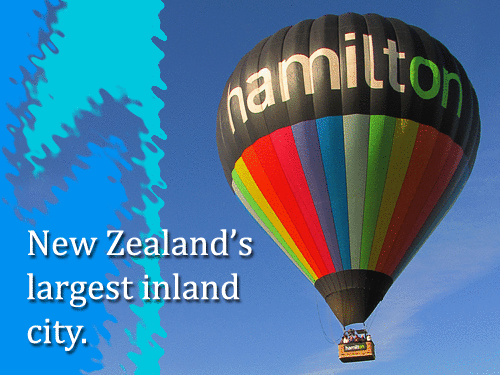
INTRODUCTORY NOTE: New Zealand has historical links with ASEAN nations that go back to the post-war period when all of them gained their independence. Since the early 1970’s when New Zealand lost its guaranteed favoured access to the UK market, we began growing our trade relations with these Southeast Asian states. They have valued the quality and abundant goods and services we pro duce, such as food, education and engineering know-how. As a result, our ex ports to ASEAN have risen from 4% to 10% of our total exports. New Zealand now trades more in a week with ASEAN than we did in a year in the early 1970’s.
ASEAN’s diversity is reflected in our own growing ASEAN country migrant com munity spearheaded by around 35,000 Filipinos making up the largest group from any of the 9 other ASEAN countries. They are joined by other smaller but established communities from across the ASEAN region. What these commu nities demonstrate – and what New Zealand makes clear through its support for ASEAN’s ambitions – is that New Zealand’s future will have an increasingly South east Asian face.
It’s heartening to note that a few of our ambassadors in some of the 10 ASEAN countries are active in strengthening bonds using the platforms of their res pective missions to promote better relations. Some have actually immersed themselves thereby becoming more conversant across a range of opportunities and issues. One such diplomat in our service is Reuben Levermore, the current Ambassador to the Philippines who provides his own perspective of what New Zealand can do to move us forward.
______________________________________________________________
New Zealand’s ASEAN Strategy
A Kiwi Ambassador’s Perspective
By: Reuben Levermore
New Zealand Ambassador to the Philippines
MAKING THE MOST OF IT
New Zealand’s relationships with the founding nations of ASEAN, including the Philippines, stretch back decades. But the nature of those relationships has changed dramatically over time. We are longstanding partners in aid and also defence and security, and join the Philippines at the East Asia Summit. But our trading ties have been transformed by the remarkable economic growth that has taken place in this region. New Zealand now exports to Southeast Asia in a single week what it exported in a single year in the early 1970s.
This growth is helping to resolve one of New Zealand’s historic challenges — the tyranny of distance from our major markets. In 1950, 90% of New Zealand exports were destined for the United Kingdom. Today, that has been turned on its head. The UK remains an important partner, but 70% of our exports are destined for the Asia-Pacific region, including 10% to the ASEAN region. In fact ASEAN recently overtook the EU as the largest trading bloc with which New Zealand does business.

A STRONG SHARED HISTORY
Our optimism for this region supported the launch last month (in July) in Auck land of New Zealand’s ASEAN Strategy. Entitled “one pathway to ten markets,” the strategy encourages New Zealanders and New Zealand businesses to focus on this region, and sets some ambitious goals. As stated by New Zealand Prime Minister John Key, “we are in a sound position to boost our relationship with the region. We have a free trade agreement in place, a strong shared history, and are geographically close.”
But what does the ASEAN Strategy mean for the Philippines? New Zealand and the Philippines have very friendly and longstanding relations, but I am sure there is more we can do together. We were delighted to welcome President Aquino to New Zealand last year, and I expect to see more visits in both di rections by government figures and businesspeople in order to encourage greater awareness of opportunities. We have some powerful forces in our favour.
At the level of business, the ASEAN-Australia-NZ Free Trade Agreement, which entered into force in 2010, is a very high quality agreement that positions us to work ever more closely with this region as it moves towards the goal of an ASEAN Economic Community.
ASEAN-KIWI COMMUNITY EMERGES
Recent years have also seen the rapid emergence of a Filipino community in New Zealand. As Filipinos make their mark in New Zealand, kiwis are becoming more aware of the Philippines and its wonderful people. That awareness will, over time, translate into greater business and tourism in both directions and, event ually, a direct air service that would cut travel time from 15-hours to less than 10.
This is a part of the world that is becoming increasingly interconnected. As it does, the Philippines have some wonderful attributes working in its favour. Its young, educated, English-speaking, and technology-savvy workforce is just one good reason to be confident about greater integration with the wider region. The ASEAN Strategy is an opportunity for more kiwis to open their eyes to this country.
Editors Comment:
New Zealand’s government and some of its private sector businesses have finally turned their gaze to the huge opportunities on store in the vast region of Southeast Asia. For starters, they are now undertaking initiatives to establish more robust ASEAN country engagements at the top level but still have some ways to go towards leveraging the capacities and capabilities of its own ASEAN migrant communities and make all these an active facet of the overall engage ment Strategy and its downstream objective of significantly improving the lot of New Zealand in the near future.
Each of these ASEAN country migrant communities in New Zealand are now also part of that future. They are much better placed than any in helping our country understand and appreciate the cultural nuances involved in building strong and trustworthy relations with people and organisations in their own countries of origin in that they are fluent speaker of their respective native languages.
It’s odd enough wanting to take something of value using one hand but with holding something else just as valuable by not offering it using the other. And because we’re talking of relatively young communities finding their way through the greater fabric of our society, perhaps more attention by government and businesses should now be given towards actively supporting some of their legit imate individual community development aspirations.
For example, there are now a handful of non-profit organisations which have been established here by some ASEAN-based country migrants who want to help lift up the aspirations of their respective communities but aren’t receiving the same level of attention or support from government, local councils or businesses who’d rather focus on pouring millions into sports development on whole or community projects desired by much older and larger ethnic communities and whose claims are that they’ve been around longer and therefore are more deser ving.
We should ask ourselves, for example, is there anything that paints as less deserving a non-profit like the Bulwagan Foundation Trust who is struggling to put funding up for a beautifully-designed cultural community centre in Welling ton or another like the SCOT Trust Foundation in Auckland who has been seeking meaningful financial support and sponsorship for establishing English Proficien cy Training Centres for Asian Migrants’ children?
Then there are also the small cultural performance groups scattered across our ASEAN migrant communities in Auckland, Wellington and other major popu lation centres who together have an explosive potential to boost tourism num bers by staging regular annual festival events that showcase the true multi-cultu ral profile of New Zealand.
Last year, the ASEAN Diplomatic Heads of Mission undertook an initiative to bring together and support these cultural performance groups consisting of Cam bodians, Thais, Malaysians, Indonesians, Filipinos and other ASEAN country migrant communities launch the first ever ASEAN Festival 2012 Event in Auck land to give New Zealanders a taste of Southeast Asia. They lobbied for meaning ful support from Auckland’s council and businesses to join in as event sponsors but the response was lukewarm at best.
With meagre resources raised from individuals at the community level instead, the event was staged anyway in November 2012 at the much smaller Logan Brown Centre in Auckland limiting the scale that was hoped for by organisers which would have established it as an annual mainstay cultural festival event.
|
Cambodia
|
Indonesia
|
|
Malaysia
|
Philippines
|
|
Thailand
|
Vietnam
|
So we wonder how many times well-meaning non-profit organisations who repre sent migrant communities like these have been turned down for grants and corporate sponsorship support on just this basis alone, that is – that they’re less deserving. That’s the equivalent of brushing off somebody asking for an appoint ment with a curt reply saying “I’ll get back to you in a fortnight” and never call ing back.
And yet, here we go designing a grand strategy to engage our ASEAN country neighbours abroad asking them to spend more money on our goods and services and lower their tariffs to zero while turning a blind eye to the need of our more silent (or shall we say invisible as in small) ASEAN country migrant communi ties. What a shame.
One of the many sad by-products of the Christchurch earthquake in 2011 is that the census scheduled for that year was delayed until 2013, when the population shift in the Canterbury Region would presumably settle down. This has been a nightmare for demographers and planners, now working without the benefit of a definitive headcount since 2006.
The surprise package is the Philippines. Based on the 2006 Census, the number of Filipino in New Zealand counted for less than some 14,000 individuals. But that number practically changed overnight since the Philippines has supplied the third or fourth highest number of skilled immigrants every year since 2007.
Significantly, this influx has taken place since the last census, making their ulti mate settlement patterns hard to track but there are good indications as to where we can expect some changes after the 2013 figures finally come out. Meantime, the NZ Ministry of Foreign Affairs and Trade’s own estimate of this number stands today at around 35,000 Filipinos, a demographic statistic which closely matches the number that the Philippine Embassy in Wellington has on its own record.
Our Prime Minister has stated emphatically that in the case of its ASEAN Strategy New Zealand needs to be making the most of a young, increasingly urban, affluent and quality-conscious region only half the distance from our traditional European customers. One thing he shouldn’t forget is that the same people who he refers to in those ASEAN countries have family members, friends, old schoolmates and acquaintances with many counterparts who have migrated to New Zealand over the years and getting in touch with each other these days is just a flick away using any smart phone or tablet.
And just as we are too referee-orientated to get things moving along, so more so are they given the Asian mindset that reputations count most. So if we want to make the most of things, we need to remember it’s always going to be a two-way proposition. We should give just as much as we’d like to take.
______________________________________________________________

 During the Spanish
During the Spanish





























